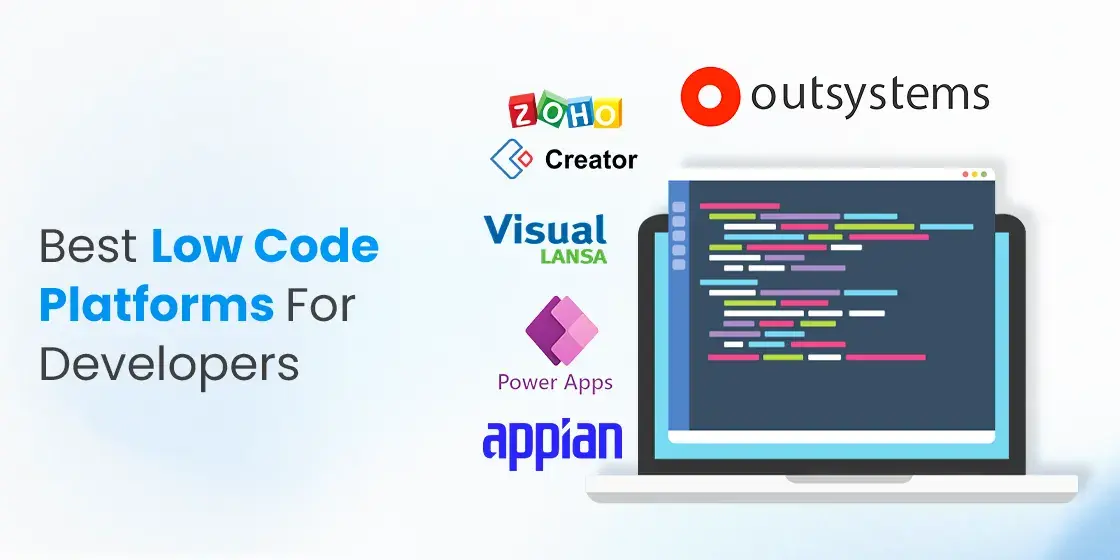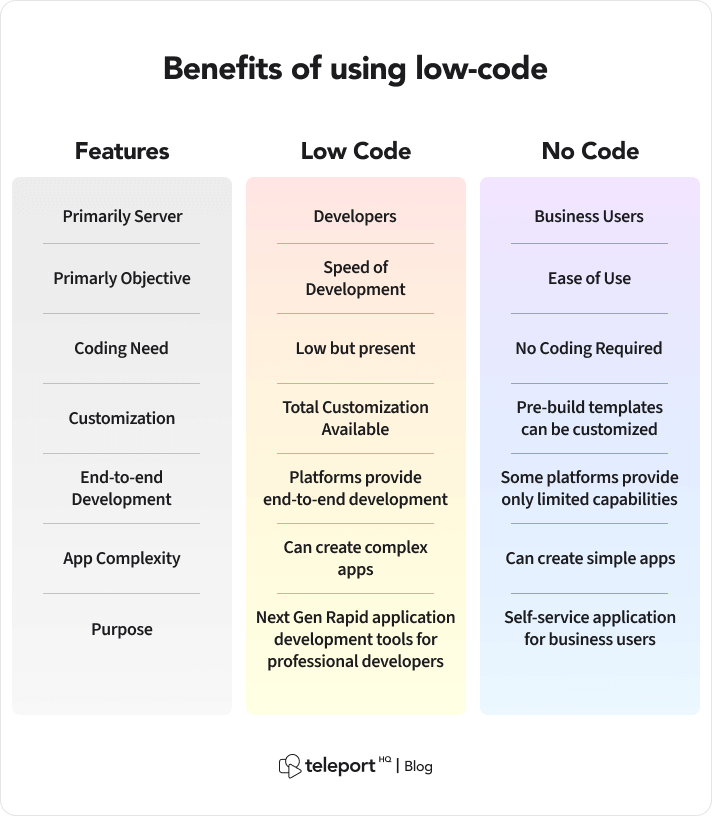Great Ideas On Deciding On Low-Code Platform Sites
Great Ideas On Deciding On Low-Code Platform Sites
Blog Article
Advantages Of Low Code Application Development In Relation To Integration Capabilities
Low-code development is an excellent method of creating applications that integrate seamlessly with various systems and services. These are the main advantages: Pre-built connectors and APIs
Many Connectors Low-code software typically includes an array of connectors that are pre-built for the most popular enterprise applications (e.g. CRMs, databases, ERPs, cloud services). This simplifies the process of integrating with these systems.
API Integration: Many low-code platforms offer API integration options, which allow developers to connect to external service and data sources with ease.
Simple to use:
Drag-and -Drop integration Integration tasks are typically completed using drag and drop interfaces. Developers and non-developers can create complex integrated systems without writing code.
Visual Workflow Designers: These software tools aid you in understanding and configuring integrations more easily.
Standardized Integration Methods:
SOAP and RESTful Service: Support for standard web services protocols such as SOAP and REST allows straightforward integration with a wide array of external software and systems.
OData and various Standards: Supporting standards such as OData provides easy access to and manipulation of data on different platforms and applications.
Real-Time Data Synchronization:
Real-Time Integrations: Lowcode platforms are able to manage data synchronization in real time between systems and applications to ensure that data is updated and uniform across an organization.
Event-Driven architecture: Certain platforms can support event-driven architectures. This lets applications react to events in real time and is crucial for interactive and dynamic apps.
Legacy System Integration:
Low-code platforms are a great source of software to connect with existing systems. They let organizations modernize IT without re-designing their current systems.
Data Migration Tool: Built-in data migration tools let data be moved from old systems to new applications that run on low code platforms.
Integration of Third-Party Services:
Integration with Cloud Services: Seamless integration with cloud-based services like AWS, Azure, and Google Cloud allows for the easy deployment and scaling of applications.
Business Applications Integration Lowcode platforms are utilized to connect various business applications, such as Salesforce, SAP, Microsoft Dynamics etc. to create a seamless workflow among different business functions.
Simple data management:
Unified Data Models: Some low-code platforms have unification of data models, which simplify managing data and integrating across various systems.
Data Connectors: Pre-configured data connectors permit easy access to and manipulation of data derived from different sources.
Security and Compliance
Secure Integrations: Low-code platforms ensure that integrations are compatible to security protocols and standard safeguarding data while in transit as well as at rest.
Security Features: These platforms typically have features to ensure that the integrations are compliant with regulations (e.g., GDPR, HIPAA), providing assurance for companies handling sensitive data.
Extensibility:
Low-code platforms can often accommodate complicated integration requirements by incorporating custom scripts or code. They allow for flexibility without compromising their accessibility.
Plug-in Ecosystems. An ecosystem of extensions and plug-ins will allow you to further enhance the integration capabilities, and add new functionalities whenever needed.
Low-code platforms are a powerful tool to create interconnected, efficient and scalable apps. They can speed up the process for connecting disparate systems and enhance the flow of information. Businesses can also benefit from existing technologies and develop new ones, while ensuring a seamless IT environment. See the top the full report about Low-code Platform for application development for more recommendations including low code platforms, cross platform mobile dev, push notifications, lowcode no code, azure sql databases, software for app development, cross platform app dev, mobile development platforms, database in azure, develop web app and more.
Benefits Of Low-Code Application Development In Terms Of Scalability, And Flexibility
Low-code application creation offers several benefits, especially in terms scalability. This is important to develop applications that grow with your business and can adapt as it grows. Here are a few principal benefits: Rapid scaling:
Cloud-Based Deployment: A lot of low-code platforms are cloud-based which allows applications to grow seamlessly with the underlying cloud infrastructure. This lets companies handle increasing loads without worrying over the management of servers.
Auto-Scaling Features - Built-in automatic scaling capabilities automatically alter resources according to the demand. This allows for constant performance in peak times without the need for manual intervention.
Flexible Architecture:
Low-code platforms encourage modular design where components can independently be designed, assessed and adapted. Modularity increases flexibility and allows for easier upgrades or expansions of certain components without affecting the entire system.
Microservices integration: The support for microservices architecture lets applications be developed as a collection loosely connected services. This improves scalability, and flexibility.
Customizable Solutions
Extensibility Low-code systems typically allow custom coding and scripting. This allows developers to extend applications' functionality beyond what comes out of the box. This means that any unique business requirements can be met without a limit.
Third-Party Integrations: The integration of third-party APIs, services or other services allows companies to enhance the capabilities of their applications by adding new functions.
Agile Development and deployment:
Continuous Delivery and Deployment: Low-code platforms are able to support agile methodologies which allow continuous integration as well as continuous delivery (CI/CD). This enables rapid deployment of new features and updates. Applications are then able to change quickly in response to market developments and feedback from users.
Iterative Development: The iterative nature of low-code development implies that applications can be incrementally improved and scaled, reducing the risks of large-scale changes and permitting greater control over growth.
Resource Optimization
Efficiency in Resource Management: Low-code platforms assist optimize resource usage by providing tools to monitor and manage application performance. This enables resources to be efficiently used, and also to be increased or decreased depending on the needs.
Load-balancing: Features that distribute workloads equally among servers increase the application’s ability to handle large traffic and ensure consistent performance.
Global Reach
Multi-Region Deployment: Low-code systems generally support deployment across multiple geographical regions, allowing businesses to provide low-latency access to users around the world. This is particularly important for applications with an international user base.
Localization Support built-in support for localization enables applications to easily be adapted to different local languages and requirements, enhancing their flexibility in different markets.
Maintenance and Updates
Low-code applications are visually and are modularly built, making it easier to perform maintenance. Updates or bug fixes can be done quickly and without a lot of downtime.
Version Control Systems for Version Control help manage changes and rollbacks, ensuring that updates can be released without risk and that previous versions can be restored if required.
Cost Efficiency:
Low-code platforms reduce development costs by reducing the requirement for extensive programming. They can also allow you to scale applications with no need for a significant cost or effort.
Pay-As-You Go Models: A lot of low-code platforms provide flexible pricing models, like pay-as you-go that align costs with actual usage and growth, providing the flexibility to finance.
The majority of low-code applications developers offer a high level of flexibility and scalability which allows businesses to quickly build scalable and flexible applications. These platforms offer quick and efficient responses to changes in needs, resource efficiency and constant improvements, which allows for the development of applications to evolve with a business. Follow the top Enterprise application development with Low-code Platform for blog tips including software for app development, azure sql databases, rapid application design, application modernisation, develop mobile application, rad application development, app platforms, build a docker container, application modernization software, ms azure sql and more.
The Benefits Of Low-Code Development For Developing Applications In Terms Of Limitations And The Possibility Of Customization
The low-code method is an unbiased method that permits significant customization and addresses limitations. Here are a few of the major advantages: Handling limitations
: .
Simplified development: Low code platforms simplify the process by providing templates and pre-built elements. This helps speed up application deployment, even for complicated ones.
Guided Workflows: Several platforms offer guided workflows and wizards that help developers navigate through the maze of processes, decreasing the risk of mistakes and guaranteeing consistency.
Scalability Solutions
Scalability is a part of the Low-code platforms often include features that allow for the development of scalable architecture. Applications are able to handle higher loads with minimal development.
Performance Monitoring: tools for monitoring and optimizing performance are built in the application to ensure it remains efficient regardless of the size.
Security and Compliance
Integrated security features of Low-code comes with built-in measures of security like encryption. Access control based on role and automated compliance checks to address the most prevalent security concerns.
Platforms are continuously changing their security procedures and measures of conformity, which assures that applications remain safe against emerging threats.
Customization:
Extensibility:
Low-code platforms permit developers to enhance functionality beyond the standard offerings by integrating custom code.
Developers are able to add extensions or modules to meet specific business needs.
APIs and Integration
API Support. Complete API support enables seamless integration with external systems and service, allowing the most extensive modification and connection.
Third-Party Services: Low-code platforms typically offer pre-built connectors for well-known third-party services, making it easier to integrate and customize applications.
Flexible UI/UX Designs:
Customizable user interfaces: Developers can alter and design user interfaces so that they meet specific branding requirements and usability needs, providing an experience that is customized for users.
Responsive Design: The built-in capabilities of responsive design guarantee that applications are able to be adapted to different screen sizes and devices.
The process of customizing Business Logic is easy:
Visual Workflow Designers: These visual tools allow you to modify and create workflows, as well as business logic, allowing programmers to design complex processes that are tailored for their needs.
Conditional Logic and Scripting: Platforms permit the use of conditional logic as well as custom scripting to handle specific business rules and scenarios.
Data Management:
Custom Data Modelling: Developers create custom models that meet specific application needs. They can tailor processing of data according to a company's specifications.
Advanced Data Processing: Integration with the latest data processing tools and capabilities allows for customization in how data is analyzed and used within the application.
Balancing Limitations with Customization:
Frameworks and Standards
Best Practices Compliance Low-code platforms facilitate the use of industry-leading practices and standards. This helps in maintaining high-quality, robust, and secure applications.
Governance Frameworks. The built-in governance frameworks make sure that any modifications do not affect the security, integrity, or compliance of the application.
Iterative Development and Feedback:
Rapid Prototyping. Developers can iterate and improve applications based on feedback from users.
Continuous Improvement: Platforms using low-code support continuous improvements that allow customization and enhancement as the business requirements change.
User Empowerment
Giving Citizen Developers the tools they need by allowing non-developers to create customisations using intuitive interfaces, low-code platforms increase the pool of contributors who can enhance and tailor applications.
Training and Support A lot of platforms offer extensive training and support resources to assist users with successful modifications that do not compromise the application's stability or performance.
Overall, the Low-code app creation gives you a framework that's robust and flexible enough to accommodate constraints while also allowing plenty of customization. This allows businesses to create and maintain applications that are both functional and adapted to the specific needs of business. All while keeping high-quality, security, scalability, and standards.
